|
|
|
Sort Order |
|
|
|
Items / Page
|
|
|
|
|
|
|
| Srl | Item |
| 1 |
ID:
103370
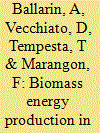

|
|
|
|
|
| Publication |
2011.
|
| Summary/Abstract |
Energy production from biomasses can be an important resource that, when combined with other green energies such as wind power and solar plants, can contribute to reduce dependency on fossil fuels. The aim of this study is to assess how agriculture could contribute to the production of bio-energy. A multi-period Weighted Goal Programming model (MpWGP) has been applied to identify the optimal land use combinations that simultaneously maximise farmers' income and biomass energy production under three concurrent constraints: water, labour and soil availability. Alternative scenarios are considered that take into account the effect of climate change and social change. The MpWGP model was tested with data from the Rovigo county area (Italy) over a 15-year time period.
Our findings show that trade-off exists between the two optimisation targets considered. Although the optimisation of the first target requires traditional agricultural crops, which are characterised by high revenue and a low production of biomass energy, the latter would be achievable with intensive wood production, namely, high-energy production and low income. Our results also show the importance of the constraints imposed, particularly water availability; water scarcity has an overall negative effect and specifically affects the level of energy production.
|
|
|
|
|
|
|
|
|
|
|
|
|
|
|
|
| 2 |
ID:
174576


|
|
|
|
|
| Summary/Abstract |
This article compares the amount of land designated for various uses in the Jewish and Arab municipalities in Israel between the years 2003–13. It is generally accepted that the Arab-Jewish conflict in Israel is heavily based on land ownership. This conflict still has implications for the policies and actions of the State of Israel on the one hand, and the attitudes and behaviours of the Arab population on the other. Two main conclusions emerge from this article. The first is that in 2013, the area per capita used for residential living in Arab localities was larger, presumably because of the lack of high-rise buildings. The second conclusion is that the areas designated for economic and public purposes in the Arab sector are much smaller. The Israeli government should therefore allocate additional government land to the Arab local authorities.
|
|
|
|
|
|
|
|
|
|
|
|
|
|
|
|
| 3 |
ID:
169741


|
|
|
|
|
| Summary/Abstract |
A growing number of cities have set ambitious mid-century targets for greenhouse gas (GHG) emissions reduction and increased use of renewable energy. Using the municipal jurisdiction of Vancouver, Canada as a case study, we integrated an energy-economy model with an urban land-use and infrastructure model to test the possible actions resulting from policies potentially available to this city government in pursuit of its 2050 target of 100 percent renewable energy and an 80 percent reduction of GHG emissions. We found that, while cities like the one we studied have some important options for reducing energy use by their inhabitants, they may lack the authority to completely transform the energy system, especially for causing a wholesale switch to renewable energy for deep decarbonization. To achieve such ambitious energy and GHG targets, cities with jurisdictional powers comparable to the city we studied are dependent to some degree on complementary GHG and energy policies from senior levels of government.
|
|
|
|
|
|
|
|
|
|
|
|
|
|
|
|
| 4 |
ID:
124333
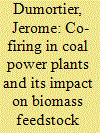

|
|
|
|
|
| Summary/Abstract |
Several states have a renewable portfolio standard (RPS) and allow for biomass co-firing to meet the RPS requirements. In addition, a federal renewable fuel standard (RFS) mandates an increase in cellulosic ethanol production over the next decade. This paper quantifies the effects on local biomass supply and demand of different co-firing policies imposed on 398 existing coal-fired power plants. Our model indicates which counties are most likely to be able to sustain cellulosic ethanol plants in addition to co-firing electric utilities. The simulation incorporates the county-level biomass market of corn stover, wheat straw, switchgrass, and forest residues as well as endogenous crop prices. Our scenarios indicate that there is sufficient feedstock availability in Southern Minnesota, Iowa, and Central Illinois. Significant supply shortages are observed in Eastern Ohio, Western Pennsylvania, and the tri-state area of Illinois, Indiana, and Kentucky which are characterized by a high density of coal-fired power plants with high energy output.
|
|
|
|
|
|
|
|
|
|
|
|
|
|
|
|
| 5 |
ID:
127224
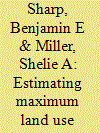

|
|
|
|
|
| Publication |
2014.
|
| Summary/Abstract |
The maximum amount of land for growing switchgrass for ethanol is estimated for a region in the southeastern U.S. Breakeven capacities are calculated for land in row crops, hay, pasture and marginal land. Characteristics of land categories inform potential land use change impacts as well as switchgrass profitability. Variable yields within and across land categories are translated into distributions of switchgrass net revenue. Breakeven curves are generated for a range of switchgrass prices. These curves provide upper bounds for further analysis of actual switchgrass adoption in context of broader economic forces and possible policy mechanisms to minimize environmental impacts. A farm-gate price of $55 Mg?1 is estimated for half of marginal and pasturelands to break even with switchgrass. At this price, only 20% of land in hay and a small fraction of row crop hectares break even. Half of hay and row crops hectares break even at approximately $90 Mg?1 and $100 Mg?1, respectively. At $60 Mg?1, sufficient land area can profitably produce switchgrass for ethanol to displace approximately 10% of gasoline consumed in Georgia, North Carolina, and South Carolina; however, this price only indicates breakeven capacity implying that higher prices may be necessary to realize 10% displacement.
|
|
|
|
|
|
|
|
|
|
|
|
|
|
|
|
| 6 |
ID:
107294


|
|
|
|
|
| Publication |
2011.
|
| Summary/Abstract |
The conversion of land to non-agricultural use in China has often been attributed to the demand for land arising from urbanization, that is, a growing urban population and the shift from agricultural to industrial activity. With a focus on Sihui ??, a county in Guangdong, this study explains land use conversion from an alternative perspective: by looking at the supply of agricultural land for conversion and what determines this supply. It gives precedence to the role of the central actors in the process - local officials - and suggests that the extent to which agricultural land is converted for non-agricultural purposes is determined by an array of structural and agential factors, including the fiscal and land resources at the disposal of local officials, the incentive structure and macro-processes which influence their decision.
|
|
|
|
|
|
|
|
|
|
|
|
|
|
|
|
| 7 |
ID:
111879


|
|
|
|
|
| Publication |
2012.
|
| Summary/Abstract |
For a long time, China has been focusing primarily on pursuing economic growth, with less concern about social and environmental development issues. This may make China's development unsustainable. In contrast to its current economic-oriented approach predominated by economic growth, this research note presents a newly proposed approach of 'major function-oriented zone' (MFOZ) that is designed by our research team and is largely accepted by the central government and incorporated into its 12th Five-Year Plan. This approach tries to rationalise China's regional development and insists that each region should have its unique functions to perform, determined by its own characteristics, conditions and requirements. With this approach, the central government is able to monitor and coordinate regional and local developments, and hence the 'Planning of MFOZ' is seen by the central government as a tool to steer spatial arrangements for the country's long-turn sustainable development.
|
|
|
|
|
|
|
|
|
|
|
|
|
|
|
|
| 8 |
ID:
172535


|
|
|
|
|
| Summary/Abstract |
Public goods in the United States are largely funded and delivered at the local level. Local public goods are valuable, but their production requires overcoming several collective action problems including coordinating supply and minimizing congestion, free-riding, and peer effects. Land use regulations, promulgated by local governments, allow communities to solve the collective action problems inherent in the provision of local public goods and maintenance of property values. A consequence of these efforts is residential segregation between cities along racial lines. I provide evidence that more stringent land use regulations are supported by whiter communities and that they preserve racial homogeneity. First, I show that cities that were whiter than their metropolitan area in 1970 are more likely to have restrictive land use patterns in 2006. Then, relying on Federal Fair Housing Act lawsuits to generate changes in land use policy, I show that restrictive land use helps to explain metropolitan area segregation patterns over time. Finally, I draw on precinct level initiative elections from several California cities to show that whiter neighborhoods are more supportive of restricting development. These results strongly suggest that even facially race-neutral land use policies have contributed to racial segregation.
|
|
|
|
|
|
|
|
|
|
|
|
|
|
|
|
| 9 |
ID:
149972
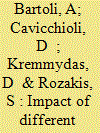

|
|
|
|
|
| Summary/Abstract |
The growing demand of maize silage for biogas production in Northern Italy has triggered an intense debate concerning land rents, maize prices and their possible negative consequences on important agri-food chains. The aim of this work is to quantify the extent to which the rapid spread of biogas raised the maize price at regional level, increasing the demand of land for energy crops. For this purpose we applied a partial-equilibrium framework simulating the agricultural sector and the biogas industry in Lombardy, under two alternative schemes of subsidization policy. Results show that policy measures implemented in 2013 – reducing the average subsidy per kWh – may contribute to enforce the complementarity of the sector with agri-food chains, decreasing the competition between energy and non-energy uses. Compared to the old scheme, maize demand for biogas would decrease, lessening the market clearing price (as well as feed opportunity cost for livestock sector) and reducing land demand for energy purposes.
|
|
|
|
|
|
|
|
|
|
|
|
|
|
|
|
| 10 |
ID:
125839
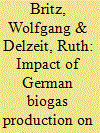

|
|
|
|
|
| Publication |
2013.
|
| Summary/Abstract |
As part of its climate policy, Germany promotes the production of biogas via its so-called Renewable-Energy-Act (EEG). The resulting boost in biogas output went along with a significant increase in production of green maize, the dominant feedstock. Existing studies of the EEG have analysed its impacts on German agriculture without considering market feedback. We thus expand existing quantitative analysis by also considering impacts on European and global agricultural markets, land use and the environment by combining a detailed location model for biogas plants, the Regionalised Location Information System-Maize (ReSi-M2012), with a global Partial Equilibrium model for agriculture, the Common Agricultural Policy Regional Impact (CAPRI) model. Our results indicate that the German biogas production is large enough to have sizeable impacts on global agricultural markets in prices and quantities, causing significant land use change outside of Germany. While profits in the agricultural sector increase, food consumer face higher prices, and subsidies for biogas production are passed on to electricity consumers. The German biogas program, as long as it is almost entirely based on non-waste feedstocks, is probably not a promising avenue towards a GHG-saving renewable energy production, but a rather expensive one.
|
|
|
|
|
|
|
|
|
|
|
|
|
|
|
|
| 11 |
ID:
180361


|
|
|
|
|
| Summary/Abstract |
Muscat, the capital of the Sultanate of Oman, has been developed since the 1970s with typical characteristics such as high urbanization rate, low-density urban sprawl, and private car based mobility. Land-use patterns favour the separation of functions, creating long distances for daily trips and a high traffic volume. State investments went into developing and improving the road network while the public transport has been neglected for a long time. In light of depleting resources and the recent decline of oil revenues, however, a first rethinking of transport policies and land use planning has set in. Diversifying the economy has become a major aim and efforts are made to encourage the private sector and to attract foreign direct investment. With regard to urban development, these policies are reflected in increasing changes in land use patterns. The paper analyses ongoing land use changes in al-Ghubra North, a multifunctional neighbourhood in Muscat, and discusses how far these forms of land use change contribute to a more sustainable urban structure and more sustainable mobility patterns.
|
|
|
|
|
|
|
|
|
|
|
|
|
|
|
|
| 12 |
ID:
186424


|
|
|
|
|
| Summary/Abstract |
Conceptual and empirical work on socio-technical transitions, such as energy transition strategies, often disregard the limited planetary capacity of available land. This paper explores the trade-offs between energy transition pathways and land use in different geographical contexts. We draw on empirical data from three contrasting case-study countries: Vietnam, New Zealand and Finland. An enhanced calculation model based on the Ecological Footprint method is used to assess land consumption for different transition pathways towards a low-carbon society. More specifically, the spatial impacts of the energy sector and its carbon dioxide emissions are assessed for different timeframes, namely the past, the present and future scenarios (by 2030 and the 2040s) based on the national energy strategies of these countries. The results show a lack of consideration in these strategies of the land area required to ensure an adequate implementation for each national territory. Hence, we argue for an acknowledgement of spatial factors, namely land availability and the geographical context, in theories and policy strategies on socio-technical transitions.
|
|
|
|
|
|
|
|
|
|
|
|
|
|
|
|
| 13 |
ID:
150772


|
|
|
|
|
| Summary/Abstract |
Feed-in tariffs and Renewable Portfolio Standards (RPS) are among the most prominent policies to address anthropogenic influence on climate change. Implementation of RPS favorably affects renewable energy supply and rural development while reducing the land available for meeting demand for food and feed resulting from global population growth. Even in the vast Great Plains of the United States, land requirements are primary considerations between increasing renewable energy capacity and food and feed production.
|
|
|
|
|
|
|
|
|
|
|
|
|
|
|
|
| 14 |
ID:
150042
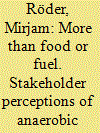

|
|
|
|
|
| Summary/Abstract |
Anaerobic digestion (AD) is of growing importance within the UK as it can make an important contribution to the countries energy and climate change targets. With the growth of the sector, discussions about competing land uses are likely to increase. For a better understanding of the synergies between agricultural land, its role and bioenergy the perception of the different stakeholders will play an important role. The perception of stakeholders related to AD, feedstock and energy crop production was investigated through interviews and a stakeholder workshop. The results indicated that from an AD operator and feedstock producer perspective, on-farm AD is more an additional activity integrated into existing agricultural systems than a renewable energy technology. The risk of a shift in agricultural practices and large areas to grow energy crops for AD is seen as low for the UK. Nonetheless, land use and related challenges need to be considered as the demand for AD feedstocks increases with the fast growth of the sector. Considering the synergies between bioenergy and agriculture as well as the motivations and benefits perceived by stakeholders will play an important role in a successful policy design to provide the required emission reduction in both sectors without subverting sustainability.
|
|
|
|
|
|
|
|
|
|
|
|
|
|
|
|
| 15 |
ID:
108794
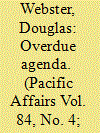

|
|
|
|
|
| Publication |
2011.
|
| Summary/Abstract |
Peri-urbanization in East Asia, the complex and "messy" process whereby new urban land is created on the periphery of cities, is still poorly understood. Professor Douglas Webster's review indicates that research on the phenomenon is highly fragmented among land use change detection analysts, sustainability scholars, institutional experts and community oriented scholars; the result is that fast-paced change on the ground driven by accelerating economic structural change in East Asia is outpacing our understanding of the dynamic.
|
|
|
|
|
|
|
|
|
|
|
|
|
|
|
|
| 16 |
ID:
182473


|
|
|
|
|
| Summary/Abstract |
Against the background of the solution-defying incidence of child labourers in Nigerian cities, this study examined the relationship between public spaces and incidence of child labourers in Ibadan Municipality, Nigeria. Data were obtained through direct counting of child labourers and cursory observation of the physical and environmental compositions of their places of operation. The direct counting was conducted for seven days of the week in the morning, afternoon and evening within defined activity-nuclei purposively selected across three densities of residential areas of the municipality: high, medium and low. The data collected were subjected to descriptive statistics. Findings showed that the incidence and categories of child labourers varied with public spaces and density of residential areas, and also followed the concentric, sector and multiple nuclei theories of urban land use. The study, therefore, recommended that urban planners and government have roles to play in offering lasting solution to the menace of child labour.
|
|
|
|
|
|
|
|
|
|
|
|
|
|
|
|
| 17 |
ID:
188566


|
|
|
|
|
| Summary/Abstract |
During the 2000s, the development of flex-fuel automotive vehicles in Brazil and rising international commodities prices allowed the Brazilian sugar-ethanol sector to grow at higher rates and expand area planted to sugarcane relative to levels verified in the 1990s. However, this land expansion increases the pressure on land-use change and management. This paper seeks to estimate the technical efficiency and decompose the total factor productivity (TFP) in the sugar-ethanol industry using a stochastic frontier framework. Primary data was obtained from an unbalanced panel of 90 sugar and ethanol producers for the harvest years from 2012/2013 to 2016/2017, providing 209 valid observations. Results suggest that mills have a small gap to increase their efficiency under the current technology, and the industry's TFP has been primarily impacted by the efficiency effects, on the other hand, SE mills might improve TFP rising their scale of production. Therefore, the results in this paper suggest that small SE mills may benefit from merging with other mills to explore economies of scale to enhance their TFP and strengthen economic competitiveness, contributing to the Brazilian environmental policy agenda.
|
|
|
|
|
|
|
|
|
|
|
|
|
|
|
|
| 18 |
ID:
118844


|
|
|
|
|
| Publication |
2013.
|
| Summary/Abstract |
Agricultural biofuels require the use of scarce land, and this land has opportunity cost. We explore the objective function of a social planner who includes a land constraint in the optimization decision to minimize environmental cost. The inclusion of this land constraint in our optimization model motivates the measurement of emissions on a per-hectare basis. Switchgrass and corn are modeled as competing alternatives to show how the inclusion of a land constraint can influence life cycle rankings and alter policy conclusions. With land use unconstrained, ethanol produced from switchgrass is always an optimal feedstock relative to ethanol produced from corn. With land use constrained, however, our results show that it is unlikely that switchgrass would be optimal in the midwestern United States, but may be optimal in southern states if carbon is priced relatively high. Whether biofuel policy advocates for one feedstock over another should consider these contrasting results.
|
|
|
|
|
|
|
|
|
|
|
|
|
|
|
|
| 19 |
ID:
108597


|
|
|
|
|
|
|
|